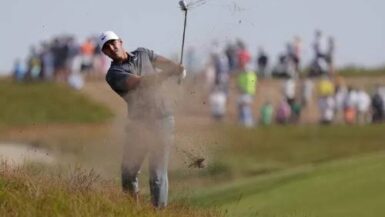MAMARONECK, NY – The sign reads “Mamaroneck” but Welcome to The Long Hot Grind over Dark Bloody Ground. U.S. Open week has arrived, where pars are the coin of the realm, birdies are an endangered species and double bogeys are ruthlessly doled out in fistfuls and stamped “paid in full” in the anguish of the contestants.Â
           Mind you, that’s before we consider that the host course for this year’s U.S. Open is Winged Foot.
           The U.S. Open is not a rock concert. Instead, players will be walking on eggshells, tightroping around a minefield of unexploded double bogeys. Fans will be on edge for a number of reasons. On one hand they’ll be absolutely riveted to the action in the hope of fireworks that so seldom come Open week due to the difficult course setup. On the other hand, they’ll be watching to see which societal profile New York will show – the respectful, reserved, and knowledgeable golf fans or the crude, drunk ugly casual fans that blighted Bethpage in 2002. Even the USGA will be fidgeting, ever overly mindful of protecting the magic, arbitrary number of “par.”Â
No, the U.S. Open is a crucible. The greedy, careless, reckless, unfocused and otherwise unworthy players are gobbled up early and with ruthless efficiency. The U.S. Open does not suffer fools lightly.
Consider the following figures. In 2005 there were 51% fewer birdies, 67% fewer eagles and 25% fewer pars at the U.S. Open than the three other majors. The U.S. Open has fewest eagles, birdies, and pars of all four of the majors and the highest scoring average to par – plus 4.1.Â
Have you seen players’ faces when they fall out of contention on Sunday? Where they were once sporting proud, furrowed brows and steely gazes, faces full of conviction, four hours later the long hot grind over dark bloody ground has shrunk the same faces, stressed them, weathered them, eroded them. Sometimes, when players break, they break hard and jagged. For them, the conscious effort to merely play out the string is nothing more than the robotic movements of a man in a freefall off the leaderboard.
Now factor in Winged Foot – the course that already boasts the highest winning score in relation to par in recent major championship history. The rough will be no less than four inches long, but more often than not it could exceed six inches. The fairways will be mere band-aids of grass averaging under 25 yards wide. The USGA recently announced the greens – the most severe ever designed by Tillinghast – would run a staggering 11.5 to 12 on the stimpmeter. That’s greased lightning anywhere, but with the wicked contours of Winged Foot’s already small greens, we may see plenty of players emulate Nicklaus – by putting completely off the green.Â
With this devastating fusion of speed and contour, greenside trouble at Winged Foot is much more severe than anything else the players will see all year. Players that short side themselves will often be grateful to two-putt what’s left. Consider this – last week at the Barclay’s, Adam Scott holed out an astonishing five times from off the green – each time between 20 and 99 yards.
Nobody has a chance of doing that this week. Â
If Winged Foot wants to crush you, it only need roll over in its sleep. And when Winged Foot is awake, it is angry and it roars. Compared to Winged Foot, Attila the Hun was a Franciscan Friar.
Even the players tread lightly. When asked if Vijay would head right to Winged Foot after winning at Westchester he replied “I have no desire to torture myself any more than I have to. I’ll ease my way into the course late tomorrow [Monday] afternoon.”Â
Sergio Garcia welcomed the challenge. “You know it’s tough going in and you have to deal with it and you steel yourself mentally. Maybe it takes everybody out worse than you and you’re last man standing.”
 Indeed at the Open, players hope the “twenty-five car crash” in turn two that eliminates half the field happens behind them. Survive and advance.Â
Welcome to the long hot grind.
But does anyone walk on more eggshells than the USGA? Why do they have to have an anxiety attack every time more than a handful of players are in the red? Players’ anguish gives way to elation of Winged Foot members and the USGA.Â
One important factor is lost in all the discussion about the winning score in relation to par – the aggregate winning score. So long as the winning score hovers around 279, or (Heaven forbid!) stays clear of the major championship aggregate scoring record, does it really matter whether the winning score is -1 or -5 or even -9? Are the members at Augusta crying a river every time -12 wins the tournament? No, the aggregate is still 276 – an entire eight shots clear of David Toms’ record of 268.
But here’s the kicker. By making par 71 – not 70 – you have no effect on whatever the aggregate winning score is, but the patrons will feel as though they saw more birdies and therefore have a more exciting tournament experience.Â
It’s sleight of hand that’s fiendishly clever in its intricacy. The players look a little better, the fans go away happier and the members get to rave about how yet again, the course stood up to the best in the world – from an aggregate scoring perspective. And consider this – if a player catches fire in a par 70 course, their a heck of a lot closer to breaking the aggregate record than if it were par 71 or 72.
But sadly, some people still parrot the tired argument about how “it’s nice to see the pros squirm.” Funny, but we certainly don’t cheer such nonsense in any other sport’s national championship game. The NCAA doesn’t raise baskets and move back three point lines for the Final Four. We don’t cheer missed three pointers and airballs. Racing doesn’t put obstacles in the road at the Daytona 500. But in golf, we end up parroting the same talking points without stopping to think how much more exciting the alternative would be. Do you actually think a few more birdies at the U.S. Open would make it less exciting?Â
But no, it’s the fans who’ll cheer the least this week. Indeed, cheers are few and far between compared to the other 51 weeks in the golf calendar. Augusta? It’s “roaring on the pines.” The U.S. Open? With -1 or even par winning, it’s pained groans and golf claps. It’s restrictor plate racing for golf. Patrons, taut with anticipation, waiting to explode into gleeful ecstasy, more often see their hopes – so tantalizingly close – dashed away in the curl of a sharply breaking six footer.
Again, the setup is the key factor. The back nine at Augusta allows players to make a move. By succeeding or failing at that borderline, tempting shot – the difference between making 3 or 6 – the Masters fosters an exciting synergy of romance, tragedy, and triumph. Players shoot up and down the leaderboard like fireworks. At the U.S. Open, players simmer and percolate. If there is sudden movement, it’s players tumbling down like dominos.Â
You want major championship excitement? The Masters has the freehold, owns the trademark. But at the U.S. Open, fans wait for the lightning bolt that almost never strikes.
The pent up tension sometimes manifests itself in crazy fans. Toto, we are not at Pinehurst this week. There, fans were polite to each other and respectful of the players. In New York, fans are almost encouraged and expected, indeed empowered by some in the media to bring the same alcohol-fueled bravado we’re forced to endure in Scottsdale to the National Championship simply because (we’re told) “it’s a New York thing.”Â
Under the guise of calling it “The People’s Open, fans were allowed, indeed in some circles encouraged, to interact with certain players in an aggressive manner and to grandstand for the TV cameras. Video clips of fans who heckled Sergio were broadcasts on the sports highlights almost as much as golf shots. This further inspired the fans to further “fan interaction.” Where was Greg Norman when we needed him? He knew exactly how to handle hecklers – challenge them to a couple of rounds behind the woodshed with a snarling ex-rugby player and shark hunter.
See if your buddy Jack Daniels can bail you out of that mess.Â
The truth is that for every “savvy New York golf fan” there is also one loudmouth mean drunk. At Bethpage in 2002, the taunting of Sergio Garcia, the juvenile and sometimes sexually offensive chants from the gallery at 17 (so deftly edited by NBC during the broadcast) were a badge of honor to some sportswriters and TV producers, but they have no place in the legitimate competitive golf world.Â
The USGA should be credited for trying to foster a family oriented product instead of a crazy beer fueled orgiastic frenzy of drunken machismo. Too often members of the media unfairly brand them Luddites. Â
Maybe “everyone’s a member at Bethpage” (sounds nice on TV) but everyone is most certainly NOT a member of Winged Foot.
Hopefully Winged Foot and the USGA will keep the drunk crazies on a tight leash. This is our national championship, not the county fair. Such displays are anathema to a true sportsman’s soul. To their credit, while the 2002 fans were allowed to torture Sergio all around the golf course for the “sin” of daring to criticize Tiger Woods (talk about mob justice), in 2003, the USGA was quick to act removing the fan who heckled Vijay Singh.Â
He was gone after strike one.
At Pinehurst, it was a moot point. North Carolinians have golf in their DNA. Hecking a golfer wouldn’t even occur to them. That’s nothing more than a brutal, bilious insult to the game. Â
Thankfully it seems fans are casting a jaundiced eye on drunk rowdy fans. One fan, who also attended the 2004 and 2005 PGA Championships said, “the best that can be said about it is that the media seems to think such conduct sells the event and builds a buzz. But to me it’s like a traffic accident, you can’t help looking form the road, but also can’t help wishing it didn’t happen. Other fans were quick to condemn it. “This is golf, not baseball” said one veteran of attending majors in the greater NYC area. “But it will be long and hot this week and some people will feel the need to act out just to get attention. If the media didn’t give them the attention, maybe they wouldn’t do it.
Welcome to the long hot grind.         Â
No, there is no room for mercy or the milk of human kindness at the U.S. Open. It’s like football in that regard. Only at the national championship of football, they don’t narrow the field to twenty yards and the goal posts to five feet and put potholes all over the field.
           Who’s going to win the tournament this year? The golf course; who did you think was going to win?  After that, it’s the guy who takes the fewest chances, properly executes the highest percentage of his shots and makes the most five footers. The crowd will cheer him, but Ran Morrissett, noted golf course architecture expert noted, “of course it’ll be less exciting all around. There are just fewer wild swings.”Â
           Fewer wild swings from the players trying borderline shots. Fewer wild swings up and down the leaderboard and hopefully fewer wild swings from fans eager to become a part of the action.
Is it any different from the last forty years?Â
Welcome to the long hot grind.





Leave a reply
You must be logged in to post a comment.